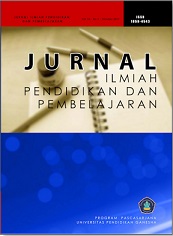PENGARUH MODEL PEMBELAJARAN HEURISTIK VEE BERBANTUAN MEDIA VIDEO TERHADAP HASIL BELAJAR IPA DITINJAU DARI MOTIVASI BELAJAR
DOI:
https://doi.org/10.23887/jipp.v2i2.15606Abstrak
This study aims to 1) describe and explain the differences in science learning outcomes between students who follow the Vee Heuristic learning model assisted by video media with direct learning models, in class VIII in SMP Negeri 5 Denpasar, 2) describe and explain differences in science learning outcomes, between students who followed the Vee Heuristic learning model with students who followed the direct learning model in groups of students who had high learning motivation, 3) described and explained the differences in science learning outcomes between students who followed the Vee Heuristic learning model, with students who followed the direct learning model in groups students who have low learning motivation. The population in this study were all students class VIII SMP Negeri 5 Denpasar which amounted to 386, with a sample of 64 people taken at random. Learning outcomes data, collected by learning outcomes test, while learning motivation data collected by questionnaire. Data were analyzed by using two-way ANOVA analysis and continued with Tukey test. The results showed that: (1) there are differences in science learning outcomes among students who followed the Vee Heuristic model assisted by video media, with students who took the direct learning model for eighth grade students in SMP Negeri 5 Denpasar with a significance value of 0.001 in "Model" (A ) less than 0.05,(2) There are differences in science learning outcomes, among students who follow the Vee Heuristic learning model assisted by video media, with students who follow the direct learning model in groups of students who have high learning motivation with a signification value of 0.001 less than 0.05. (3) There are differences in science learning outcomes, between students who joined the Vee Heuristic learning model assisted by video media, and students who took the direct learning model in groups of students who had low learning motivation with a signification value of 0.001 less than 0.05. The implications in this study are efforts to apply the Vee Heuristic learning model assisted by video media in science learning and efforts to apply direct learning models in science learning, by paying attention to student learning motivation.Referensi
Aunurrahman. 2011. Belajar dan Pembelajaran. Bandung: Alfabeta
Dahar, R. W. 2006. Teori-teori Belajar & Pembelajaran. Jakarta: Erlangga.
Dananjaya, IG. A. B. Suastra, I.W. & A.A.I.A.R. Sudiatmika. 2016. Penerapan Model Quantum Learning Berbantuan Media Video sebagai Upaya Meningkatkan Motivasi dan Hasil Belajar Siswa. Jurnal Wahana Matematika dan Sains.Vol. 9, No. 2, Oktober 2016.
Dantes, N. 2010. Analisis Varian. Singaraja: Undiksha.
Feronita, Y. L. Oktariani, S. & Sri Adi Widodo. Hubungan antara Kenakalan Remaja, Minat Belajar dan Motivasi Belajar dengan Hasil Belajar Matematika Siswa. Prosiding Seminar Nasional Etnomatnesia. T.t.http://jurnal.ustjogja.ac.id/index.php/etnomatnesia/article/view/2400/1361.pdf (Diakses 18 Maret 2017).
Hamalik, O. 2011. Proses Belajar Mengajar. Jakarta: Bumi Aksara
Mahadewi, LPP. Tastra, IDK. & I K. Sudarma. 2006. Media Video Pembelajaran. Singaraja: Jurusan Teknologi Pendidikan, FIP, Undiksha.
Senjawati, E. 2014. Prosding Seminar Nasional Pendidikan Matematika. Perbandingan Pemahaman Matematik Siswa yang Pembelajarannya Menggunakan model Pembelajaran Heuristik Vee dengan yang Menggunakan Cara Biasa (hlm. 334-341). Bandung: Program Pasca Sarjana STKIP.
Suastra, I. W. 2009. Pembelajaran Sains Terkini. Singaraja: Undiksha.
Suparno, P. 1997. Filsafat Konstruktivisme dalam Pendidikan. Yogyakarta: Kanisius.
Supriadi, D. & Sutrisno. 2007. Ilmu Pengetahuan Alam (Studi dan Pengajaran). Bogor: Yudistira.
Suryandari. S., Widha & Suparmi. 2016. Pengembangan Media Pembelajaran Menggunakan Video Dokumenter Berbasis Inkuiri Terbimbing Berorientasi pada Motivasi Belajar Siswa. Jurnal Inkuiri. ISSN: 2252-7893, Vol 5, No. 1, 2016 (hal 85-94)
Susanto, A. 2013. Teori Belajar Pembelajaran di Sekolah Dasar. Jakarta: PT. Kharisma Putra Utama. Pembelajaran Program Pascasarjana Universitas Negeri Malang.
Tegeh,I M. 2008. Media Pembelajaran. Singaraja: Program Doktor Teknologi
Utami, D. L. 2017. Penyusunan Media Pembelajaran Video Animasi Sistem Saraf Untuk Meningkatkan Motivasi Belajar Siswa Kelas Xi Sma Negeri 1 Kasihan Bantul. Jurnal Prodi Pendidikan 40 Biologi Vol 6 No 2 tahun 2017
Unduhan
Diterbitkan
Cara Mengutip
Terbitan
Bagian
Lisensi
Authors who publish with the Jurnal Ilmiah Pendidikan dan Pembelajaran (JIPP) agree to the following terms:
- Authors retain copyright and grant the journal the right of first publication with the work simultaneously licensed under a Creative Commons Attribution License (CC BY-SA 4.0) that allows others to share the work with an acknowledgment of the work's authorship and initial publication in this journal.
- Authors are able to enter into separate, additional contractual arrangements for the non-exclusive distribution of the journal's published version of the work (e.g., post it to an institutional repository or publish it in a book), with an acknowledgment of its initial publication in this journal.
- Authors are permitted and encouraged to post their work online (e.g., in institutional repositories or on their website) prior to and during the submission process, as it can lead to productive exchanges, as well as earlier and greater citation of published work. (See The Effect of Open Access)










